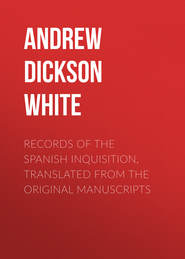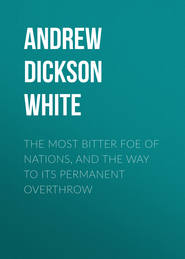По всем вопросам обращайтесь на: info@litportal.ru
(©) 2003-2025.
✖
The Warfare of Science
Настройки чтения
Размер шрифта
Высота строк
Поля
79
Bertrand, Fondateurs de l'Astron. Mod., p. 61. Flammarion, Vie de Copernic, chap. ix. As to the time when the decree of condemnation was repealed, various authorities differ. Artaud, p. 307, cited in an apologetic article in Dublin Review, September, 1865, says that Galileo's famous dialogue was published in 1744, at Padua, entire, and with the usual approbations. The same article also declares that in 1818 the ecclesiastical decrees were repealed by Pius VII., in full Consistory. Whewell says that Galileo's writings, after some opposition, were expunged from the Index Expurgatorius in 1818. Cantu, an authority rather favorable to the Church, says that Copernicus's work remained on the Index as late as 1835. Cantu, Histoire Universelle, vol. xv., p. 483; and with this Th. Martin, not less favorable to the Church, but exceedingly careful as to the facts, agrees.
80
See Weld, History of the Royal Society, vol. ii., p. 56, for the facts and the admirable letter of Priestley upon this rejection.
81
Bruhns and Lassell, Life of Humboldt, London, 1873, vol. ii., p. 411.
82
For the very amusing details of the English attempt, and of the way in which it was met, see De Morgan, Paradoxes, p. 42. For Pastor Knak and his associates, see Revue des Deux Mondes, 1868.
83
For a striking account, gathered from eye-witnesses of this frightful scene at the execution of Bruno, see letter of Scioppius in appendix to vol. iv. of Libri, Hist. des Mathématiques.
84
As a pendant to this ejaculation of Kepler may be cited those wondrous words of Linnæus: "Deum omnipotentem a tergo transeuntem vidi et obstupui."
85
For papal bull representing the earth as a flat disk, see Daunou, Études Historiques, vol. ii., p. 421.
86
For Bruno's conjecture (in 1591), see Jevons, vol. ii., p. 299. For Kant's part in the nebular hypothesis, see Lange, Geschichte des Materialismus, vol. i., p. 266. For value of Plateau's beautiful experiment very cautiously estimated, see W. Stanley Jevons, Principles of Science, London, 1874, vol. ii., p. 36. Also, Elisée Réclus, The Earth, translated by Woodward, vol. i., pp. 14-18, for an estimate still more careful. For a general account of discoveries of nature of nebulæ by spectroscope, see Draper, Conflict between Religion and Science. For a careful discussion regarding the spectra of solid, liquid, and gaseous bodies, see Schellen, Spectrum Analysis, pp. 100, et seq. For a very thorough discussion of the bearings of discoveries made by spectrum analysis upon the nebular hypothesis, ibid., pp. 532-537. For a presentation of the difficulties yet unsolved, see article by Plummer, in London Popular Science Review for January, 1875. For excellent short summary of recent observations and thought on this subject, see T. Sterry Hunt, Address at the Priestley Centennial, pp. 7, 8. For an interesting modification of this hypothesis, see Proctor's recent writings.
87
For a very careful discussion of Albert's strength in investigation and weakness in yielding to scholastic authority, see Kopp, Ansichten über die Aufgabe der Chemie von Geber bis Stahl, Braunschweig, 1875, pp. 64, et seq. For a very extended and enthusiastic biographical sketch, see Pouchet. For comparison of his work with that of Thomas Aquinas, see Milman, History of Latin Christians, vol. vi., 461. Il était aussi très-habile dans les arts mécaniques, ce que le fit soupçonner d'être sorcier.Sprengel, Histoire de la Médecine, vol. ii., p. 389.
88
For the charge of magic against scholars and others, see Naudé, Apologie pour les grands hommes accusés de Magie, passim. Also, Maury, Hist. de la Magie, troisième édit., pp. 214, 215. Also, Cuvier, Hist. des Sciences Naturelles, vol. i., p. 396.
89
See Études sur Vincent de Beauvais par l'Abbé Bourgeat, chaps. xii., xiii., xiv. Also, Pouchet, Histoire des Sciences Naturelles au Moyen Age, Paris, 1853, pp. 470, et seq.
90
For work of Aquinas, see St. Thomas Aquinas, Liber de Cœlo et Mundo, section xx. Also, Life and Labors of St. Thomas of Aquin, by Archbishop Vaughan, pp. 459, et seq. For his labors in natural science, see Hoefer, Histoire de la Chimie, Paris, 1843, vol. i., p. 381. For theological views of science in middle ages, and rejoicing thereat, see Pouchet, Hist. des Sci. Nat. au Moyen Age, ubi supra. Pouchet says: "En général au milieu du moyen âge les sciences sont essentiellement chrétiennes, leur but est tout-à-fait religieux, et elles semblent beaucoup moins s'inquiéter de l'avancement intellectuel de l'homme que de son salut eternel." Pouchet calls this "conciliation" into a "harmonieux ensemble" "la plus glorieuse des conquêtes intellectuelles du moyen âge." Pouchet belongs to Rouen, and the shadow of the Rouen Cathedral seems thrown over all his history. See, also, L'Abbé Rohrbacher, Hist. de l'Église Catholique, Paris, 1858, vol. xviii., pp. 421, et seq. The abbé dilates upon the fact that "the Church organizes the agreement of all the sciences by the labors of St. Thomas of Aquin and his contemporaries." For the theological character of science in middle ages, recognized by a Protestant philosophic historian, see the well-known passage in Guizot, History of Civilization in Europe; and by a noted Protestant ecclesiastic, see Bishop Hampden's Life of Thomas Aquinas, chaps. xxxvi., xxxvii. See, also, Hallam, Middle Ages, chap. ix. For dealings of Pope John XXII., and kings of France and England, and republic of Venice, see Figuier, L'Alchimie et les Alchimistes, pp. 140, 141, where, in a note, the text of the bull Spondent Pariter is given.
91
The Novum Organon, translated by the Rev. G. W. Kitchin, Oxford, 1855, chap. lxv.
92
Novum Organon, chap. lxxxix.
93
Novum Organon, chap. xciii.
94
Bacon, The Advancement of Learning, edited by W. Aldis Wright, London, 1873, pp. 47, 48.
95
For a very contemptuous statement of Lord Bacon's claim to his position as a philosopher, see Lange, Geschichte des Materialismus, Leipsic, 1874, vol. i., p. 219. For a more just statement, see Brewster, Life of Sir Isaac Newton. See, also, Jevons, Principles of Science, London, 1874, vol. ii., p. 298.
96
Kopp, in his Ansichten, pushes criticism even to some skepticism as to Roger Bacon being the discoverer of many of the things generally attributed to him; but, after all deductions are carefully made, enough remains to make Bacon the greatest benefactor to humanity during the middle ages.
97
For an account of Bacon's treatise, De Nullitate Magiæ, see Hoefer.
98
Kopp, Geschichte der Chemie, Braunschweig, 1843, vol. i., p. 63; and for a somewhat reactionary discussion of Bacon's relation to the progress of chemistry, see a recent work by the same author, Ansichten über die Aufgabe der Chemie, Braunschweig, 1874, pp. 85, et seq. Also, for an excellent summary, see Hoefer, Hist. de la Chimie, vol. i., pp. 368, et seq. For summaries of his work in other fields, see Whewell, vol. i., pp. 367, 368. Draper, p. 438. Saisset, Descartes et ses Précurseurs, deuxième édition, pp. 397, et seq.Nourrisson, Progrès de la pensée humaine, pp. 271, 272. Sprengel, Histoire de la Médecine, Paris, 1865, vol. ii., p. 397. Cuvier, Histoire des Sciences Naturelles, vol. i., p. 417. As to Bacon's orthodoxy, see Saisset, pp. 53, 55. For special examination of causes of Bacon's condemnation, see Waddington, cited by Saisset, p. 14. On Bacon as a sorcerer, see Featherstonaugh's article in North American Review. For a good example of the danger of denying full power of Satan, even in much more recent times, and in a Protestant country, see account of treatment of Bekker's Monde Enchanté by the theologians of Holland, in Nisard, Histoire des Livres Populaires, vol. i., pp. 172, 173.
99
Henri Martin, Hist. de France, vol. iv., p. 283.
100
On Bacon as a "Mahometan," see Saisset, p. 17.
101
For proofs that the world is steadily working toward great discoveries as to the cause and prevention of zymotic diseases and of their propagation, see Beale's Disease Germs, Baldwin Latham's Sanitary Engineering, Michel Lévy, Traité d'Hygiène Publique et Privée, Paris, 1869. And for very thorough summaries, see President Barnard's paper read before Sanitary Congress in New York, 1874, and Dr. J. C. Dalton's Anniversary Discourse on the Origin and Propagation of Disease, New York, 1874.
102
Antonio de Dominis, see Montucla, Hist. des Mathématiques, vol. i., p. 705. Humboldt, Cosmos.Libri, vol. iv., pp. 145, et seq.
103
For Porta, see Hoefer, Hist. de la Chemie, vol. ii., pp. 102-106. Also, Kopp. Also, Sprengel, Hist. de la Médecine, iii., p. 239. Also, Musset-Parthay.







